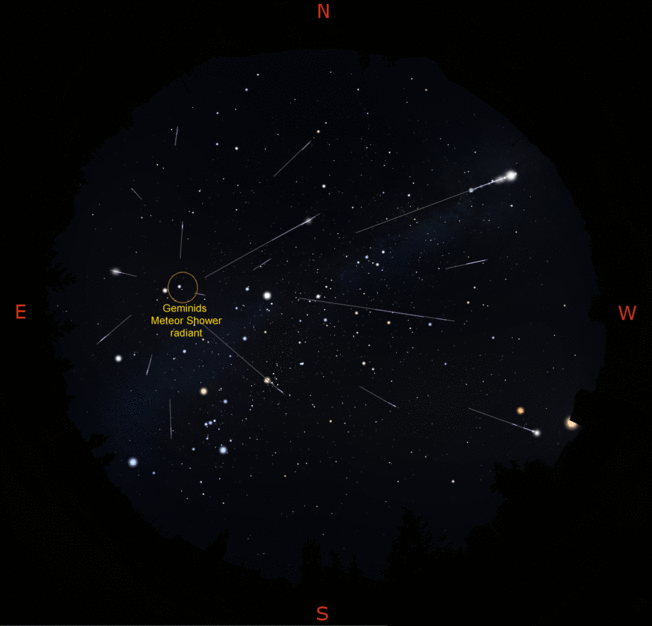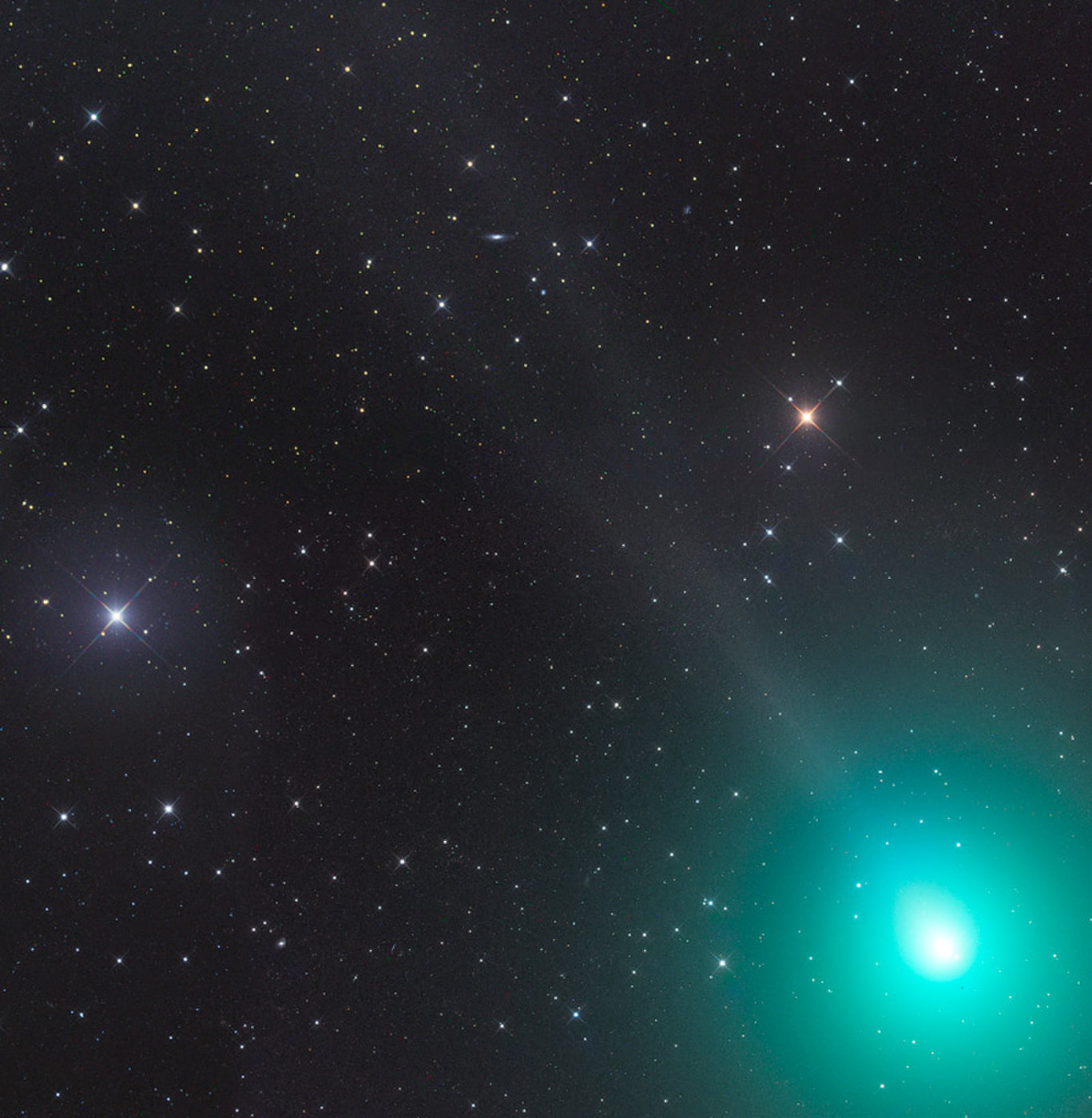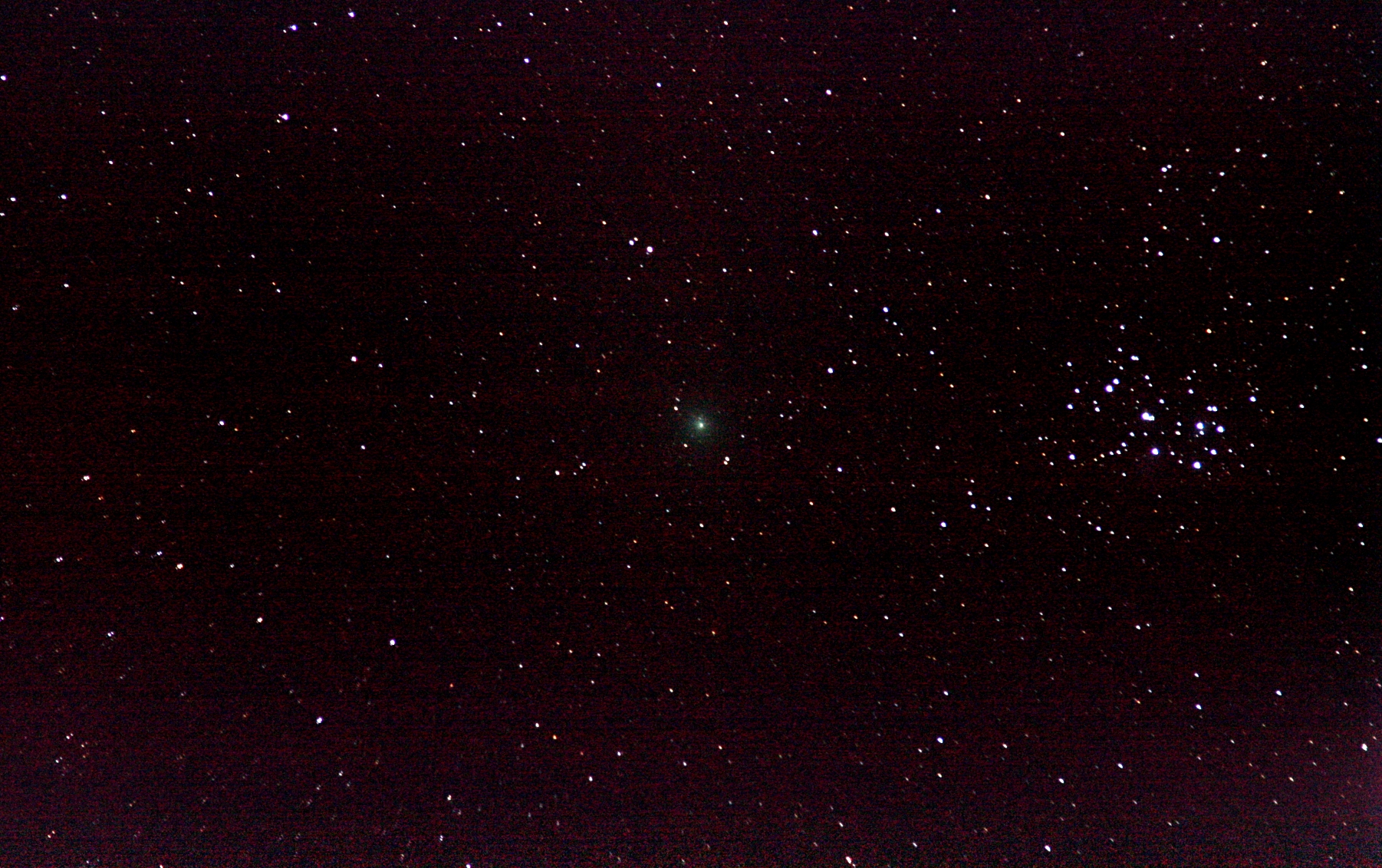GTA_Skies for December 2018 by Ian Shelton
Geminids
 The Geminids meteor shower is arguably now the best and most reliable meteor shower of the year, though it happens at admittedly a less comfortable time in terms of temperature. But Winter skies in Canada are much better than the Sumertime in terms of the number of bright, colourful stars you can see. And you don't have to stay up late to see this: it's truly dark by 6:00 pm during December.
The Geminids meteor shower is arguably now the best and most reliable meteor shower of the year, though it happens at admittedly a less comfortable time in terms of temperature. But Winter skies in Canada are much better than the Sumertime in terms of the number of bright, colourful stars you can see. And you don't have to stay up late to see this: it's truly dark by 6:00 pm during December.
You might see a few Geminids in early December, but that number will rapidly increase as we reach the night of peak activity beginning on the evening of Thursday December 13th. Assuming you are observing away from city lights with a completely unobstructed view of a perfectly clear sky, you can expect to see up to two meteors per minute. For those near the GTA on Dec. 13th, sunset comes at 4:39 pm EST and the sky should be dark enough to start seeing meteors by 5:30 pm. The 1st Quarter Moon will be passing due south at 5:20 pm on Dec.13, and on Dec.14 the Moon will be beautifully placed just 4-1/2 degrees below Mars. Unfortunately, the moon will brighten the sky and make it impossible to see the fainter meteors. So you will need to wait till 10:40 pm on Dec.13 and till 11:40 pm on Dec.14 for the Moon to set if you want to see the most meteors possible. But even without the Moon interfering, note that you will see significantly more meteors per hour by continuing to observe into the early morning hours, as the side of the Earth you are on turns more directly towards where Earth is traveling in its orbit about the Sun, overtaking more meteors as Earth plows through their path in space. This is just like why you see far more rain drops striking your front windshield rather than your rear window when driving through a rain shower.
 You don't need any special equipment to view the meteors, but I strongly
recommend using a full bodylength reclining chair so you can comfortably be
looking almost straight up at the sky for long periods of time. You will of course need warm clothing, and maybe a blanket, some snacks and some friends to share the occasion. Give yourself at least fifteen minutes to let your eyes get used to the dark so you can see the most meteors. And try to avoid using your cell phone or any other sources of light, as even a few seconds looking at your phone's display can undo the fifteen minutes it took to get used to the dark. The meteors can and will appear everywhere in the sky, though they will seem to be coming from the direction of the constellation Gemini (hence, their name). The Geminids will remain active for a few days after its peak, but with progressively fewer meteors to see each night, and with more interference from the Moon.
You don't need any special equipment to view the meteors, but I strongly
recommend using a full bodylength reclining chair so you can comfortably be
looking almost straight up at the sky for long periods of time. You will of course need warm clothing, and maybe a blanket, some snacks and some friends to share the occasion. Give yourself at least fifteen minutes to let your eyes get used to the dark so you can see the most meteors. And try to avoid using your cell phone or any other sources of light, as even a few seconds looking at your phone's display can undo the fifteen minutes it took to get used to the dark. The meteors can and will appear everywhere in the sky, though they will seem to be coming from the direction of the constellation Gemini (hence, their name). The Geminids will remain active for a few days after its peak, but with progressively fewer meteors to see each night, and with more interference from the Moon.
Comet 46P/Wirtanen
 The usually faint and little-studied periodic Comet Wirtanen has had four modest encounters with Jupiter in its last 17 orbits, two of these since the comet was discovery by Carl Wirtanen in 1948. The Jupter encounter in the 1980s made Wirtanen considerably more interesting, bringing the comet's orbit close enough to make it a "Near-Earth Object" (NEO): objects that potentially could impact the Earth. The comet will be at its closest to the Sun on December 12 at a distance that's actually 8 percent further than Earth's orbital distance from the Sun (150 million km). But just 4 days later, the comet will also pass at its closest distance from the Earth, just 30 times the distance between the Earth and the Moon. This makes Comet Wirtanen the tenth closest comet in modern history.
The usually faint and little-studied periodic Comet Wirtanen has had four modest encounters with Jupiter in its last 17 orbits, two of these since the comet was discovery by Carl Wirtanen in 1948. The Jupter encounter in the 1980s made Wirtanen considerably more interesting, bringing the comet's orbit close enough to make it a "Near-Earth Object" (NEO): objects that potentially could impact the Earth. The comet will be at its closest to the Sun on December 12 at a distance that's actually 8 percent further than Earth's orbital distance from the Sun (150 million km). But just 4 days later, the comet will also pass at its closest distance from the Earth, just 30 times the distance between the Earth and the Moon. This makes Comet Wirtanen the tenth closest comet in modern history.
Having the comet's closest approach to the Earth coincide with when it's closest to the Sun means the comet could become bright enough to be visible with the unaided eye if viewed from a location and time free of light pollution. This meas viewing on a clear night away from both man-made lights and when the Moon is not up in the sky. The best time for viewing the comet therefore is likely to be during the week of December 6th through 13th. After this, growing moonlight will likely interfere with your ability to see the comet, even as the comet is getting closer to the Earth.
On December 9th, the comet will be rising in the East as nightfall begins and is at its highest (passing due South) at around 10 pm (see the starchart below). The comet is up until 3 am and should become incresingly easier to see with each additional night. It will almost certainly be visible in binoculars if you are viewing away from city lights. Some predict it could become bright enough to see with the unaided eye; but I don't believe this is likely to happen, given its performance during several of its last favorable passes near the Earth and Sun. Still, comets are notoriously unpredicatable and brings to mind Comet Holmes, which in 2007 went from being visible only in large telescopes (as predicted) to suddenly becoming easily visible with the unaided eye following an unexpected outburst.
UPDATE: 2018-12-16
 On the night of Dec.15-16, I succeeded in photographing the comet from near Preston Lake, Ontaio using a Canon XTi camera on a tripod. Skies cleared after midnight, and were completely clear by ~2:30 AM on Dec.16 with a SQM reading of 19.5 mag/sq-arcsec (vs 17.6 measured in RH an hour earlier when the Moon was still up). Using 5 sec exposures at iso 1600 and a 24-105 zoom lens set at 105mm and f4, the comet is clearly seen without excessive trailing. 30 sec exposures at the same zoom setting and f4 (iso 1600) shows the comet more clearly and provides a much smoother (and brighter) sky background; but the comet and stars are now badly trailed without using sidereal tracking.
On the night of Dec.15-16, I succeeded in photographing the comet from near Preston Lake, Ontaio using a Canon XTi camera on a tripod. Skies cleared after midnight, and were completely clear by ~2:30 AM on Dec.16 with a SQM reading of 19.5 mag/sq-arcsec (vs 17.6 measured in RH an hour earlier when the Moon was still up). Using 5 sec exposures at iso 1600 and a 24-105 zoom lens set at 105mm and f4, the comet is clearly seen without excessive trailing. 30 sec exposures at the same zoom setting and f4 (iso 1600) shows the comet more clearly and provides a much smoother (and brighter) sky background; but the comet and stars are now badly trailed without using sidereal tracking.
The image at left was made by aligning and co-adding ("stacking") twenty-one individual 5 second exposures. The frame measures about 8x12 degrees on the sky and shows the comet passing by the Pleadies star cluster on the right (west) side of the image.
To help you find the comet, click on the image below to open an animation [HD video version] showing the comet's position (centred within the red tick marks) for each night in December.

[or click here for an animated GIF version]
Clear skies everyone!
Ian Shelton, DDOD Chair
 The Geminids meteor shower is arguably now the best and most reliable meteor shower of the year, though it happens at admittedly a less comfortable time in terms of temperature. But Winter skies in Canada are much better than the Sumertime in terms of the number of bright, colourful stars you can see. And you don't have to stay up late to see this: it's truly dark by 6:00 pm during December.
The Geminids meteor shower is arguably now the best and most reliable meteor shower of the year, though it happens at admittedly a less comfortable time in terms of temperature. But Winter skies in Canada are much better than the Sumertime in terms of the number of bright, colourful stars you can see. And you don't have to stay up late to see this: it's truly dark by 6:00 pm during December.



